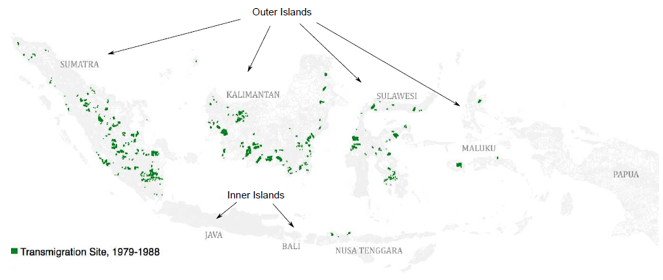
Better matching between transmigrants’ origin and destination agroclimate and languages can substantially improve productivity and integration
Forced migration due to climate change, natural disasters, and conflict is among the most important policy challenges of the 21st century. Myers (2005) argues that as higher temperatures lead to rising sea levels, coastal flooding, droughts, and new rainfall patterns, these changes could displace nearly 200 million people by 2050. In South Asia alone, extreme weather events are expected to uproot over 60 million people (Stern 2007). War will also continue to displace populations, as exemplified by the recent conflict in Syria that has already produced more than nine million refugees and is expected to produce even more.1
While income transfers may be a first best solution to compensate victims of natural disasters or conflict, the poor state of land and housing markets in many developing countries often makes cash-based solutions difficult to implement. As an alternative, some governments are considering rural-to-rural resettlement programs, where displaced migrants are given new farmland and housing in newly developed areas. For such programs to be effective, they need to be well suited to the needs of poor households in rural areas, where rain-fed agriculture remains a primary source of subsistence.
Matching matters
A well-designed resettlement program would allow migrants to maximise their long-run productivity in a new environment. In designing these programs, a crucial question is whether the skills acquired in one setting are transferrable to economic activities in another. If skills are not readily transferable, then policymakers may need to play an active role as a matchmaker, using information on settlers’ skills at their origin to match the environment at the destination.
Although barriers to skill transferability are very important in theory, measuring the magnitude of their impacts, or productivity losses from poor matches, is difficult. Voluntary migrants tend to choose locations where they expect their skills to be most transferable and they have been selecting favourable locations for millennia. For example, Steckel (1983) and Diamond (1997) document a tendency for migrants to move from east to west, rather than from north to south, as they settled the agricultural frontier. Because favourable soil and climate conditions shape destination choices due to a desire to work in familiar environmental conditions, it is typically not possible to draw inferences about the magnitudes of barriers to skill transferability from observational data.
In recent work, we use a natural experiment—Indonesia’s largest resettlement program, known as the Transmigration Program—to measure barriers to skill transferability (Bazzi et al. 2016). Between 1979 and 1988, the government of Indonesia relocated nearly 2 million voluntary migrants from rural areas in Java and Bali to rural areas in the Outer Islands, to reduce population pressures and stimulate agricultural production (see Figure 1). Transmigrant households were given free transport to the newly created settlements. Upon arrival, they received free housing, a two-hectare plot of farmland (allocated by lottery) and provisions for the first few growing seasons, including seeds, tools, and food.2
Figure 1 Map of transmigration villages

Source: Bazzi et al. (2016).
Due to various logistical constraints and an ad hoc, ‘plan-as-you-proceed’ approach to program implementation (World Bank 1988), transmigrants experienced as-if random assignments to destinations. Some transmigrants were sent to similar locations in the Outer Islands, while others were sent to very different farming environments. None had a say in their ultimate destination. The program’s unprecedented geographic scope, with destination villages scattered across the Outer Islands, meant that migrants from diverse origins across Java/Bali are observed across a range of new agroclimatic conditions in the destinations. This gave rise to wide-ranging, plausibly exogenous variation in the assignment of migrants to destinations, which allows us to identify the causal effect of barriers to skill transferability on productivity.
We use rich geospatial data on soil, hydrography, topography, and climate to construct an agroclimatic similarity index that measures the similarity in the farming environment between a migrant’s origin and her destination. Given the as-if random assignment of transmigrants, the coefficient of this similarity measure in an agricultural productivity regression identifies the causal effect of skill transferability on migrants’ productivity.
We find that skill transferability has large effects on village-level rice productivity. Rice was the focal crop of the program and is a primary staple, both for Indonesia and for more than half of the world. Our estimates imply that, on average, an increase in agroclimatic similarity by one standard deviation leads to a 20% increase in village-level rice productivity. This translates to an additional 0.5 tons per hectare. This effect is roughly equivalent to twice the productivity gap between farmers with no schooling versus those that have completed middle school.
Where matching matters more
Interestingly, skill transferability has nonlinear effects on productivity. Migrants from the most dissimilar origins face the largest productivity losses. This suggests not only that resettlement planners should try to match migrants to similar destination environments but also that they should be particularly concerned about minimising bad matches. A simulation that mimics these policy recommendations suggests that a more optimal assignment of transmigrants could have increased aggregate rice production in the new settlements by 27%.
Policy implications
Although matching resettled populations to destinations is a good way to ensure that migrants remain productive, other coping mechanisms are possible. Many food crops like rice are particularly sensitive to agroclimatic conditions, but other crops, such as cash crops like palm oil, appear less sensitive to growing conditions and may be an alternative for farmers who face unfamiliar growing conditions. Moreover, due to the complexities of soil management (De Datta 1981), barriers to transferability appear to be greatest for soil-specific knowledge. Resettlement programs need to be coupled with effective agricultural extension services that can train farmers in how to manage crops in their new environments.
One lesson from the Transmigration Program has broader implications for resettling diverse migrant populations. We find that migrants whose native language is similar to the local indigenous language in the Outer Islands are more likely to switch into trading and services occupations. Beyond highlighting the importance of careful matching in allocating migrants across destinations, this finding also suggests that language training can help facilitate adaptation.
Another important feature of the Transmigration Program was its goal of encouraging mixing between geographically and culturally disparate ethnic groups. By sending inner-Island migrants to new villages in the outer-Islands, and by encouraging locals to migrate to these settlements, the program created an initial shock to ethnic diversity, which we show persisted for decades. In follow-up work, we further investigate how this diversity shock affected interethnic cooperation and identity choices in the new settlements (Bazzi et al. 2017).
We find that the increased scope for contact with other groups gave rise to a significant increase in both interethnic marriage as well as the adoption of the national language, Bahasa Indonesia, as the primary language used at home. These changes constitute significant shifts in the process of socialisation and identity formation with broader implications for nation building. Children raised in these settings exhibit stronger national affinity, less co-ethnic bias, and weaker attachment to their own ethnic identity. Interestingly, we observe the strongest shifts in the most diverse communities where Inner and Outer Island ethnic groups are in roughly equal proportion.
From a policy perspective, there are a few key forces giving rise to this increased integration amidst such a large and abrupt increase in local diversity. First, a lottery-based policy of residential desegregation within communities fostered contact between groups that may not have otherwise chosen to mix locally. Repeated social and economic contact may have accelerated learning, breaking down stereotypes, and promoting cooperation. Second, groups resettled in more remote locations tended to integrate faster on account of more limited scope for finding alternative venues for economic activity and exchange. Moreover, integration is deeper in contexts where migrants had incentives to interact with locals to learn about optimal farming practices. Hence, skill differences could be harnessed to encourage intergroup exchange.
Resettlement programs are logistically challenging and expensive. The land clearing associated with resettlement can be environmentally damaging, resulting in deforestation that could lead to even greater greenhouse gas emissions—exacerbating the problem that they were trying to solve.3 Nevertheless, with careful planning, resettlement remains a feasible and politically attractive option for coping with forced migration in many settings. The lessons from Indonesia’s Transmigration Program should help inform ongoing resettlement planning.
Photo credit: Asian Development Bank.
References
Bazzi, S, A Gaduh, A Rothenberg and M Wong (2016), “Skill transferability, Migration, and development: Evidence from population resettlement in Indonesia”, American Economic Review 106(9): 2658-2698.
Bazzi, S, A Gaduh, A Rothenberg and M Wong (2017), “Unity in diversity: Ethnicity, migration and nation building in Indonesia”, Working Paper.
De Datta, S K (1981), Principles and Practices of Rice Production, Hoboken: John Wiley & Sons.
de Sherbinin, A, M Castro, F Gemenne, M M Cernea, S Adamo, P M Fearnside, G Krieger, et al. (2011), “Preparing for resettlement associated with climate change”, Science 344(6055): 456-457.
Diamond, J (1997), Guns, Germs, and Steel, New York: W W Norton & Company.
Fearnside, P M, (1997), “Transmigration in Indonesia: Lessons from its environmental and social impacts”, Environmental Management 21(4): 553-570.
Myers, N (2005), “Environmental refugees: An emergent security issue”, OSCE 13th Economic Forum Documents.
Oliver-Smith, A and A de Sherbinin (2014), “Resettlement in the Twenty-First century”, Forced Migration Review 45: 23-25.
Steckel, R H (1983), “The economic foundations of East-West migration during the 19th century”, Explorations in Economic History 20(1): 14–36.
Stern, N (2007), The Economics of Climate Change: The Stern Review, Cambridge, UK: Cambridge University Press.
World Bank (1988), Indonesia: The Transmigration Program in Perspective, World Bank Country Study, Washington, DC: World Bank.
Endnotes
[1] See http://syrianrefugees.eu/ on the Syrian refugee crisis. Further background on resettlement policy challenges can be found in de Sherbinin et al. (2011) and Oliver-Smith and de Sherbinin (2014).
[2] Journey to a New Life: The Human Face of Indonesia (1984) is a short film about the Transmigration Program that follows a family moving from East Java to Southeast Kalimantan. You can watch it here.
[3] For instance, Fearnside (1997) argues that the Transmigration Program was an important source of deforestation in Indonesia, particularly in peat forest areas, which led to substantial greenhouse gas emissions.




